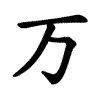万
| ||||||||
Translingual
| Stroke order | |||
|---|---|---|---|
| Stroke order | |||
|---|---|---|---|
 | |||
Han character
万 (radical 1, 一+2, 3 strokes, cangjie input 一尸 (MS), four-corner 10227, composition ⿸丆𠃌)
Related characters
- 萬 (Orthodox traditional form)
References
- KangXi: page 76, character 3
- Dai Kanwa Jiten: character 10
- Dae Jaweon: page 137, character 7
- Hanyu Da Zidian: volume 1, page 9, character 3
- Unihan data for U+4E07
Chinese
Glyph origin
| Historical forms of the character 万 | |
|---|---|
| Shang | Western Zhou |
| Oracle bone script | Bronze inscriptions |
 |
 |
Unknown. Used as a tribal name in oracle inscriptions. Used as a number since the Spring and Autumn and Warring States periods.
Various theories have been proposed for its original meaning:
- Qu Wanli, Qiu Xigui and others propose that it originally refers to a type of dancer-musicians. This usage is attested in the oracle inscriptions. This may be supported by ancient literature, e.g. Shijing, which mentions a type of dance called 萬舞/万舞.
- Lin Yiguang proposes that it is an ancient form of 丏 (OC *meːnʔ), acting as a phonetic component in 賓 (OC *mpin).
- Some propose that it is a differentiated form of 亥.
Etymology 1
| For pronunciation and definitions of 万 – see 萬 (“scorpion; etc.”). (This character, 万, is the simplified and variant form of 萬.) |
Notes:
|
Usage notes
Also used in a trisyllabic surname.
Pronunciation
Japanese
| 万 | |
| 萬 |
Readings
As a simplification and variant of 萬:
- Go-on: もん (mon)
- Kan-on: ばん (ban, Jōyō)
- Kan’yō-on: まん (man, Jōyō)
- Kun: よろず (yorozu, 万)←よろづ (yorodu, historical)
- Nanori: かず (kazu); かつ (katsu); すすむ (susumu); たか (taka); つむ (tsumu); つもる (tsumoru); ま (ma); ゆる (yuru); よし (yoshi)
As part of the surname 万俟:
Noun
万 (shinjitai kanji, kyūjitai kanji 萬, hiragana まん, rōmaji man)
- ten thousand, 10,000, myriad
- 1999 October 17, “3
万 年 の白 亀 [30,000-Year White Turtle]”, in BOOSTER 5, Konami:- 3万年も生きつづけている巨大カメ。守備力が高い。
- Sanman-nen mo ikitsuzukete iru kyodai kame. Shubiryoku ga takai.
- A giant turtle that has lived for over 30,000 years. It has high defense strength.
- 3万年も生きつづけている巨大カメ。守備力が高い。
-
Derived terms
- 万一 (man'ichi, “perhaps”)
- 万が一 (mangaichi)
- 万機 (manki, “state affairs”)
- 万華鏡 (mangekyō, “kaleidoscope”)
- 万才 (mansai, “ten thousand years old”)
- 万作 (mansaku, “witch hazel”)
- 万善 (manzen, “ten thousand virtues”)
- 万全 (manzen, “perfect”)
- 万灯 (mandō, “ten thousand lights”)
- 万引 (manbiki, “shoplifting”)
- 万歩計 (manpokei, “pedometer”)
- 万葉仮名 (man'yōgana)
- 万葉集 (man'yōshū)
- 万力 (manriki)
Adverb
万 (shinjitai kanji, kyūjitai kanji 萬, hiragana ばん, rōmaji ban)
- (followed by a negative) even if, never
- (followed by a negative) no matter what
Derived terms
- 万感 (bankan, “flood of emotions”)
- 万軍 (bangun)
- 万芸 (bangei, “versatility”)
- 万古 (banko, “old time, all this time, eternity”)
- 万斛 (bankoku)
- 万劫 (bangō, “an extremely long period of time”)
- 万死 (banshi, “critical state of the life”)
- 万寿 (banju), 万寿 (manju, “longevity”)
- 万丈 (banjō, “hurrah”)
- 万乗 (banjō, “sovereignty”)
- 万状 (banjō, “diversification”)
- 万博 (banpaku, “international exposition”)
- 万万 (banban, “very much”)
- 万民 (banmin, “all the people, the entire nation”)
- 万有 (ban'yū)
Etymology 3
| Kanji in this term |
|---|
| 万 |
| よろず Grade: 2 |
| kun’yomi |
⟨yo2ro2du⟩ → /yorodu/ → /yorod͡zu/ → /yorozu/
From Old Japanese.[4] Found in the oldest sources, such as the Man'yōshū (c. 759 CE).[5]
Appears to be a compound or inflection, but the derivation is unclear.
Pronunciation
References
- 2006, 大辞林 (Daijirin), Third Edition (in Japanese), Tōkyō: Sanseidō, →ISBN
- 1998, NHK日本語発音アクセント辞典 (NHK Japanese Pronunciation Accent Dictionary) (in Japanese), Tōkyō: NHK, →ISBN
- 1997, 新明解国語辞典 (Shin Meikai Kokugo Jiten), Fifth Edition (in Japanese), Tōkyō: Sanseidō, →ISBN
- 1988, 国語大辞典(新装版) (Kokugo Dai Jiten, Revised Edition) (in Japanese), Tōkyō: Shogakukan
- c. 759, Man'yōshū (book 20, poem 4408), text here
Korean
References
- Supreme Court of the Republic of Korea (대한민국 대법원, Daehanmin-guk daebeobwon) (2015). Table of Hanja for Personal Names (인명용한자표, inmyeong-yonghanjapyo).
Vietnamese
Han character
万: Hán Việt readings: vạn[1][2]
万: Nôm readings: vàn[2][3], vạn[1], muôn[2]
- Alternative form of 萬
References
- Nguyễn et al. (2009).
- Trần (2004).
- Hồ (1976).